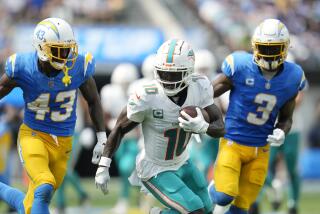SPEEDY RECOVERY
- Share via
DAVIE, Fla. — The Miami Dolphins’ low-risk, ball-control, run-oriented, post-Marino offense caused too much excitement last season for coach Dave Wannstedt’s taste.
The conservative approach meant lots of close, low-scoring games. Eight were decided by a touchdown or less, including four in a row in December.
“Every game came down to the last couple of minutes,” Wannstedt said.
In a bid to become more explosive, the Dolphins went shopping for speedy receivers and acquired three during the offseason. James McKnight, Dedric Ward and rookie Chris Chambers are expected to help Miami reach the end zone faster and more often.
Ward was sidelined last week by a slight stress fracture in his left foot that may force him to miss the entire preseason. But receiver now ranks among the Dolphins’ deepest positions, and the newcomers are faster than any pass-catcher Miami had last year.
“Those guys are streaking up and down the field,” safety Brian Walker said. “They can run and jump, and you can see the difference. When they come up that sideline, you definitely have to respect them.”
The additions don’t mean a revamped offense. With 1,139-yard rusher Lamar Smith returning, Miami still wants to run first. But better speed at receiver should stretch defenses, transform short passes into an occasional long gain and provide open targets more often for Jay Fiedler.
“We’re going to be a ball-control offense, but at the same time we’re going to be an explosive offense,” McKnight said. “We’re going to go through Lamar, but we’re going to have guys who are going to light up the scoreboard, guys who are going to get downfield and make big plays. Last year they didn’t really have that explosiveness or deep threat.”
In 2000, Dan Marino’s first year of retirement, the Dolphins mounted their best running attack since his second season in 1984. But they ranked 26th in the NFL in offense because they were 27th in passing. And although the Dolphins ranked third in points allowed, they lost five times.
“I figure if we can average 21 points a game, we’ll be in the Super Bowl. No doubt about it,” McKnight said.
McKnight, who led the Dallas Cowboys last year with 52 catches for 926 yards, was signed as an unrestricted free agent. A month later they signed Ward, who caught 54 passes for 801 yards for the New York Jets in 2000.
Chambers, a second-round draft choice from Wisconsin, may turn out to be the most significant addition -- and the first major acquisition at receiver via the draft since O.J. McDuffie in 1993.
“His athletic ability is as good as anyone we have,” Wannstedt said.
The coach doesn’t expect the changes at receiver to produce a flurry of 80-yard touchdowns. He’s merely hoping that the Dolphins don’t have to grind out every first down.
“It’s very difficult in this league to put together a 12-play drive,” Wannstedt said. “How do you make a 12-play drive a six-play drive? One play has to be 25 or 30 yards.”
An occasional big play would take some heat off Fiedler, who struggled badly late last season, his first as an NFL starter. He threw two touchdowns and 11 interceptions in the final five games, and a lackluster pass-catching corps didn’t help.
Now, with three newcomers to augment leading receiver Oronde Gadsden, the Dolphins have a nice mix of youth, experience, size and speed.
“We made more big plays in one week of training camp than we probably made in three a year ago, and it’s because of the receivers,” Wannstedt said. “The trap you can’t fall into is to forget what got us here. We’ve got to run the ball, and use the receivers to strike with big plays when the situation is right.”
More to Read
Go beyond the scoreboard
Get the latest on L.A.'s teams in the daily Sports Report newsletter.
You may occasionally receive promotional content from the Los Angeles Times.










